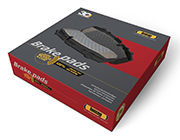A look to the future: copper-free friction materials
31 Dec 2018
In early 2015 an agreement was signed in the USA by automotive representatives, state officials and environmental agencies to reduce the use of copper and other materials in motor vehicle brake pads. The agreement calls for reducing copper in brake pads to <5% (by weight) by 2021, and 0.5% by 2025.

In addition to copper, this voluntary initiative reduces mercury, lead, cadmium, asbestiform fibres, and chromium-six salts in motor vehicle brake pads.
The initiative was put in place to decrease runoff of these materials from roads into streams, rivers, and lakes. Copper from water runoff can have a detrimental effect on fish, amphibians, invertebrates, and plant life.
Setting a new standard, and opening a worldwide debate on the use of such material, there is no doubt that the development of copper-free eco-friendly brake-friction material is one area of change that will significantly impact future brake development.
One company that has already sat up and noticed is Polish based, Lumag – suppliers of OE quality brake pads and drums for commercial vehicles, and the leading BRECK brand of brakes for passenger vehicles. The company has confirmed that efforts are currently being made to replace copper using novel conducting rock-fibres and thermographite. In line with the US Initiative, Lumag is looking to reduce copper use to less than 5% by 2021, with 2026 earmarked for less than 0.5% copper usage.
Colin Smit, Lumag UK Managing Director, said: “As a leading part supplier we have a responsibility to minimise our impact upon the environment. For some time now, we have been looking into alternative materials to replace copper and will continue to forge ahead in creating OE quality brake parts that meet these requirements without compromising on quality, performance or parts longevity.”